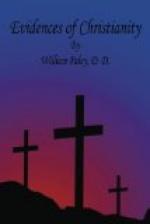which the historian proposed to himself was to trace
each particular to its origin, and to fix the certainty
of many things which the reader had before heard of.
In Saint John’s Gospel the same point appears
hence, that there are some principal facts to which
the historian refers, but which he does not relate.
A remarkable instance of this kind is the ascension,
which is not mentioned by St. John in its place, at
the conclusion of his history, but which is plainly
referred to in the following words of the sixth chapter;
“What and if ye shall see the Son of man ascend
up where he was before?” (Also John iii. 31;
and xvi. 28.) And still more positively in the words
which Christ, according to our evangelist, spoke to
Mary after his resurrection, “Touch me not,
for I am not yet ascended to my Father: but go
unto my brethren, and say unto them, I ascend unto
my Father and your Father, unto my God and your God.”
(John xx. 17.) This can only be accounted for by the
supposition that St. John wrote under a sense of the
notoriety of Christ’s ascension, among those
by whom his book was likely to be read. The same
account must also be given of Saint Matthew’s
omission of the same important fact. The thing
was very well known, and it did not occur to the historian
that it was necessary to add any particulars concerning
it. It agrees also with this solution, and with
no other, that neither Matthew nor John disposes of
the person of our Lord in any manner whatever.
Other intimations in St. John’s Gospel of the
then general notoriety of the story are the following:
His manner of introducing his narrative (ch. i. ver.
15.)—“John bare witness of him, and
cried, saying” evidently presupposes that his
readers knew who John was. His rapid parenthetical
reference to John’s imprisonment, “for
John was not yet cast into prison,” (John iii,
24.) could only come from a writer whose mind was
in the habit of considering John’s imprisonment
as perfectly notorious. The description of Andrew
by the addition “Simon Peter’s brother,”
(John i. 40.) takes it for granted, that Simon Peter
was well known. His name had not been mentioned
before. The evangelist’s noticing the prevailing
misconstruction of a discourse, (John xxi. 24.) which
Christ held with the beloved disciple, proves that
the characters and the discourse were already public.
And the observation which these instances afford is
of equal validity for the purpose of the present argument,
whoever were the authors of the histories.
These four circumstances:—first, the recognition of the account in its principal parts by a series of succeeding writers; secondly, the total absence of any account of the origin of the religion substantially different from ours; thirdly, the early and extensive prevalence of rites and institutions, which resulted from our account; fourthly, our account bearing in its construction proof that it is an account of facts which were known and believed at the time, are sufficient,




